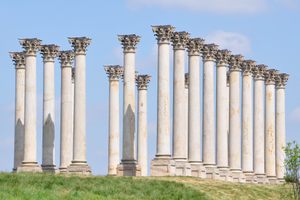About
Few structures in U.S. history can match the level of architectural analysis directed at the Capitol Building, which has attracted national interest ever since George Washington laid the cornerstone on September 18, 1793. However, over the intervening years the location of that piece of memorial rock has become something of a mystery, and the Architect of the Capitol’s office has been looking for it ever since.
Locating a cornerstone may seem like a straightforward affair. Experience says that they can reliably be found where the walls of a building come together at right angles, usually with an inscription a few feet off the ground marking the date. However, what do you do when the bicameral structure in question was built, expanded and continually modified over the course of two centuries, with dozens of layered advancing and receding facades?
Add into the riddle the fact that we know that George Washington set the cornerstone below ground level on the basement level. A silver plaque under that is the only marker, and it’s proven an elusive geocache. It’s unclear which of the many corners is the corner, and you’d have to tear down the Capitol in order to check them all!
The Architect of the Capitol began its hunt for the cornerstone as the Capitol neared its centennial birthday in 1893. The public pressure was on and you can almost imagine lawmakers reminding the architect you had one job. Nothing conclusive was found. In the 1950s they reopened the cold case, this time with metal detectors and experts from the U.S. Geological Survey. Still nothing.
Finally, in 1991 Architect George White was going through primary source materials when he realized that all previous searches under the Senate side of the Capitol were based on a faulty assumption, the rock was more plausibly located under the southern House of Representatives. White thought that he hit pay dirt when excavations beneath the House's basement coffee shop revealed something that had the smell of cornerstone.
"It looks like it was prepared for a ceremony," Architect of the Capitol George White said optimistically. "It's a big flat chunk of stone that weighs several tons by our estimates, from its size and composition, and it's not something you'd be casual about." While the rest of the foundation was composed of rubble and mortar, this find was five feet long and flat on the top and bottom.
However, as they dug deeper one irksome reality dogged the discovery: There was no memorial plaque to be found. "Without that silver plate, who's to say?" Allen couched the find. "In terms of location, it's right. In terms of size, it's right. Every criteria are there, except for the silver plate, which unfortunately is the most important criterion." Today the site of the 1991 White excavation has been covered over by a fresh piece of concrete, and the hunt continues.
Related Tags
Know Before You Go
The 1991 excavation was under the southeastern corner of the original House of Representatives wing, which is today known as Statuary Hall. Free tours of the building are offered through congressional offices. Savvy interns should be able to show you the way.
Community Contributors
Added By
Published
December 12, 2017
Sources
- https://www.aoc.gov/first-cornerstone
- http://articles.chicagotribune.com/1993-09-17/news/9309170120_1_capitol-lawn-silver-plate-wrong-place
- https://townhall.com/columnists/craigshirley/2008/04/02/romancing-the-cornerstone-n1120567
- https://townhall.com/columnists/craigshirley/2008/04/02/romancing-the-cornerstone-n1120567
- https://www.senate.gov/artandhistory/history/minute/George_Washington_Lays_Capitol_Cornerstone.htm
- https://drpence.files.wordpress.com/2013/08/img_4047.jpg
- https://www.c-span.org/video/?50490-1/us-capitol-cornerstone
- https://www.aoc.gov/explore-capitol-campus/buildings-grounds/capitol-building/first-cornerstone
- https://www.senate.gov/artandhistory/history/minute/George_Washington_Lays_Capitol_Cornerstone.htm
- https://www.chicagotribune.com/news/ct-xpm-1993-09-17-9309170120-story.html

























